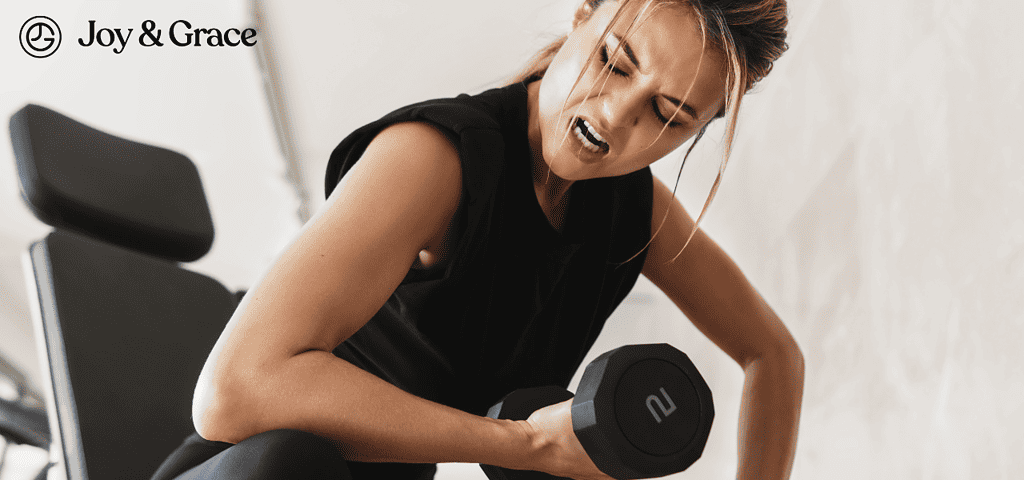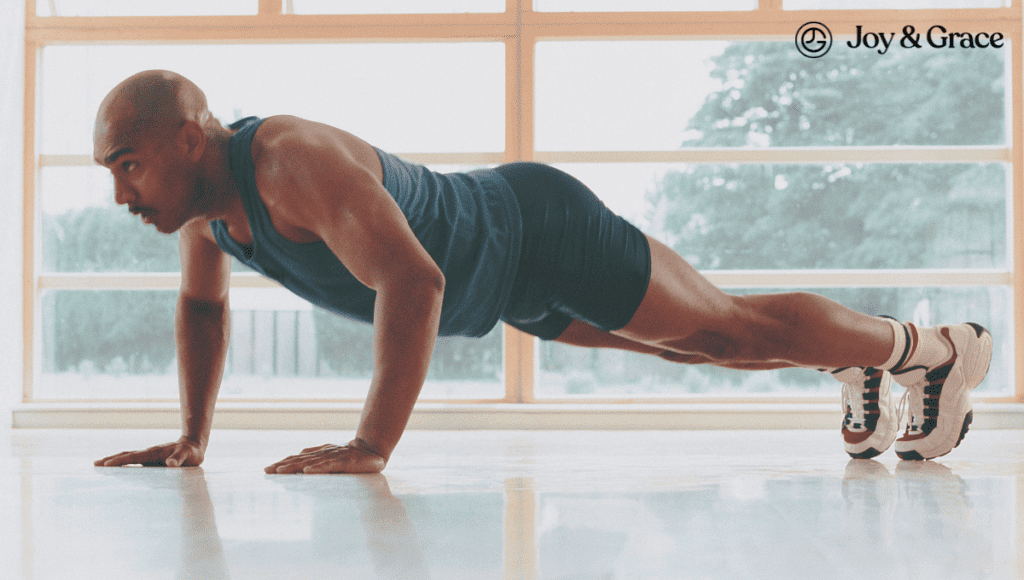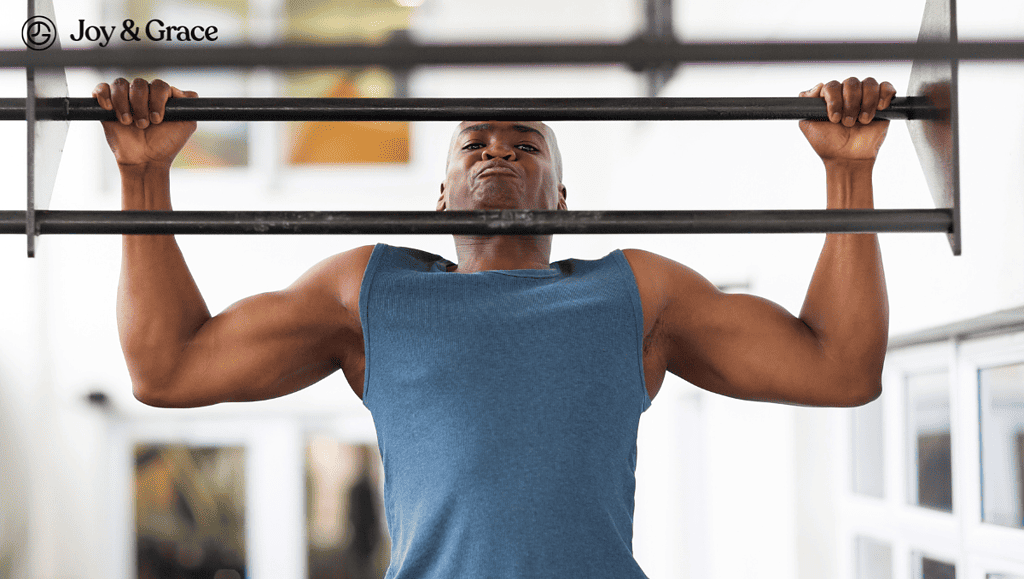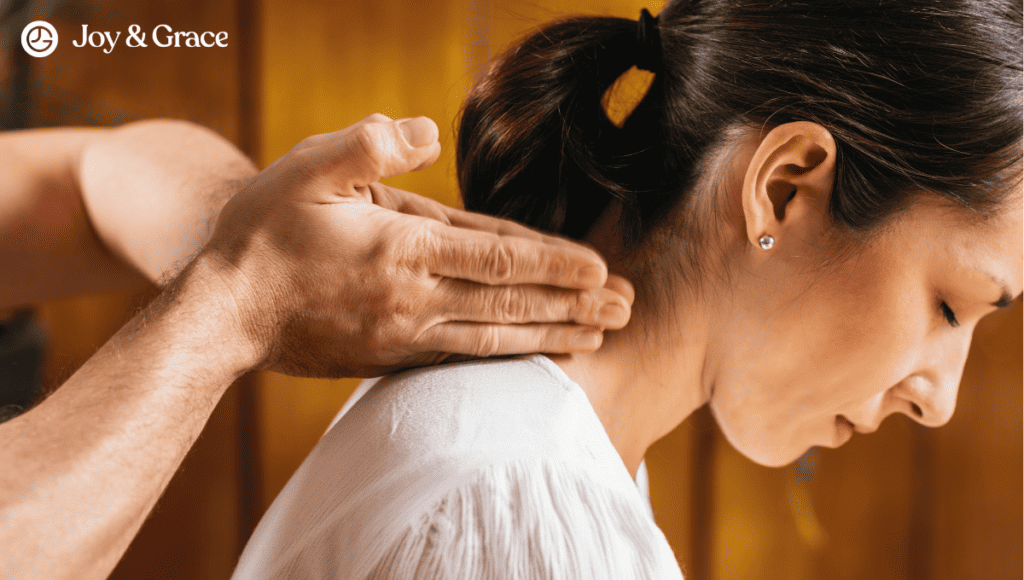Bicep curls are a popular exercise for strengthening the arm muscles. However, for some people, this exercise causes shoulder pain (as well as others).
The pain can range from mild to severe and originate from different anatomical structures.
In this article, we'll explore the causes and symptoms of shoulder pain during bicep curls and provide tips for a safe and effective workout.
Why Do My Shoulders Hurt When Doing Bicep Curls?
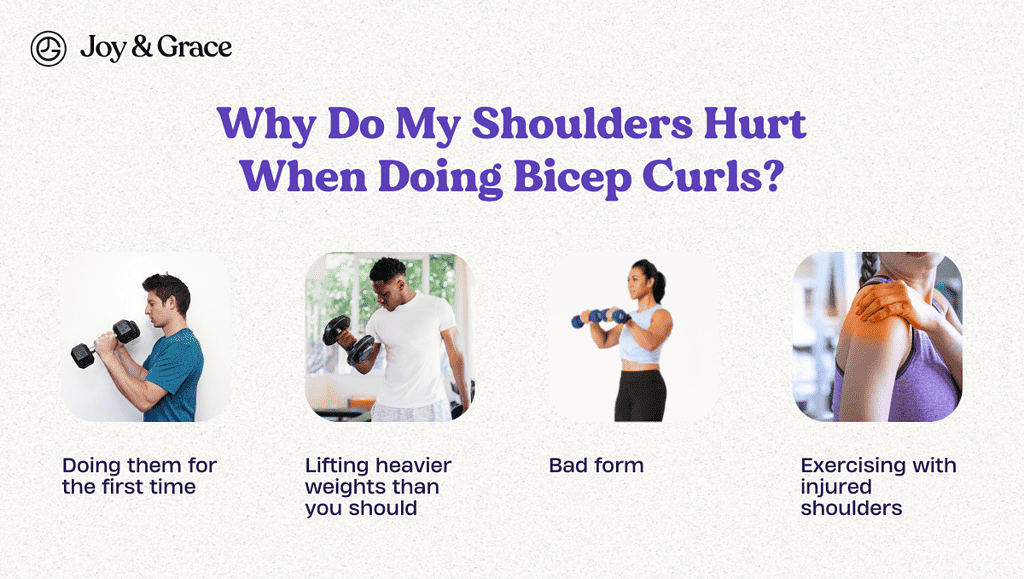
The culprits of shoulder pain during bicep curls could be:
- Doing them for the first time
- Lifting heavier weights than you should,
- Bad form, or
- Exercising with injured or still not adequately healed shoulders.
However, if we want to answer the question more specifically, some elementary anatomy review is necessary.
The biceps muscles, which do most of the work during bicep curls, attach in three places in our arms:
One lower site near the elbow and two "upper" sites inside the shoulder joint. Muscles attach to our bones via tendons. The structure of muscle connections is bone-lower part tendon-muscle-upper part tendon-another bone.
Keep in mind that, despite this, the shoulder is one of the body's most complex joints. Often, the pain can be hard to localize from exactly which specific structure it is coming from.
Still, based on human anatomy, the origin of shoulder pain during biceps curls can be broadly classified into:
- The bicep muscle's upper tendon, which is attached to the shoulder, or,
- The shoulder joint itself.
Based on these structures which are affected, we could further classify the pain into "normal" and "not so normal":
- Mild pain could be nothing to worry about.
Some pain levels during or after bicep curls can be completely normal.
Even if you keep your shoulders still, with the perfect form, extra weight is still being "suspended" on the shoulders during bicep curls. You may especially notice this if you're doing them for the first time or with heavier weights.
If your shoulders feel a little sore, but you find no difficulty finishing your workout, that could be completely normal. Again, this mainly applies if you're either a beginner are lifting very heavy weights otherwise.
However, shoulder pain that persists is never normal. We would advise not continuing your workout if you notice that you're experiencing pain every time you do bicep curls.
- Severe pain could be caused by inflammation or injury of the bicep muscle tendon or the shoulder joint.
Severe or persisting shoulder pain could be a sign of something more serious.
Bad form could irritate the part of the bicep muscle tendon attached to the shoulder joint or, even worse, severely injure or tear it.
That could lead to lesions such as biceps tendonitis or complete bicep tendon tears.
Another cause could be that your shoulder is injured or not adequately healed from a prior injury. By doing curls, you could be activating the pain by putting extra weight on the shoulders.
Below, we will explore the causes of shoulder pain during curls, question after question.
Can Bicep Curls Cause Tendonitis?
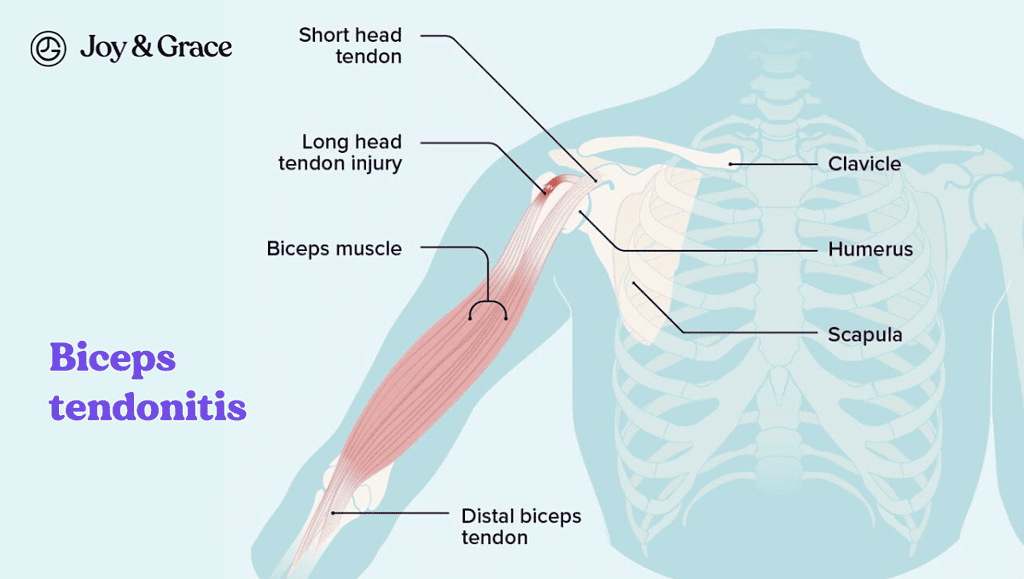
Bicep tendonitis could be a cause of shoulder pain during bicep curls.
It is one of the conditions that originates from the bicep tendon, based on the classification we mentioned earlier.
Because the muscle tendon attaches inside the shoulder joint, the pain is also localized to the shoulder.
This condition happens when the upper biceps tendons get inflamed or irritated.
Bicep curls put repetitive force in these tendons, and by some time, they can be irritated. That's especially true if you're doing them incorrectly.
What Does Bicep Tendonitis Feel Like?
Biceps tendonitis usually causes pain in the front of the shoulder and weakness.
Other symptoms of bicep tendonitis include:
- Pain or tenderness in the front of the shoulder, which worsens with overhead lifting or activity
- Pain or achiness that moves down the upper arm bone
- An occasional snapping sound or sensation in the shoulder
Most of the time, rest and medicine will help.
On the other hand, persistent irritation could lead to more serious conditions.
Some of these conditions include bicep tears, whether partial or complete tears. We will discuss these just a bit later in the article.
Can You Do Bicep Curls With Bicep Tendonitis?
You shouldn’t do bicep curls if you have bicep tendonitis.
The only way you can exercise your biceps is through physical therapy.
Then, once you can move without pain, you can start a slow, step-by-step return to activity and sports.
Physical therapy is very important for improving the strength and flexibility of the biceps and shoulder muscles (like the rotator cuff).
Rotator cuff injuries and bicep tendonitis are sometimes closely linked, as we’ll now see.
Do Bicep Curls Hurt Rotator Cuff?
Bicep curls don't primarily work the rotator cuff muscles.
However, they can still indirectly strain the rotator cuff muscles, especially if done incorrectly.
You can hurt your rotator cuff if you do bicep curls with weights that are too heavy or engage your shoulders incorrectly by not keeping them still.
Another way biceps curls could hurt the rotator cuff is when they first cause bicep tendon tears.
Without treatment, biceps tendon tears can lead to many other shoulder problems. These problems range from chronic tendonitis to shoulder impingement and rotator cuff injuries.
Bicep Tendon Tears And Rotator Cuff Injuries - The Connection
Although uncommon, bicep curls could lead to severe injury if they're incorrectly performed for a long period of time.
A bicep tendon tear can be a slow injury that worsens as the tendon wears down from repeated motions. These repeated movements can cause tiny tears in the tendon, weakening it over time and eventually causing it to break.
A rotator cuff tear is often linked to a bicep tendon tear, and doctors usually check anyone with a torn tendon of the biceps for a rotator cuff tear.
A study with 111 patients showed that rotator cuff injuries are strongly linked to tears in the biceps tendon.
When the tendon snaps into the arm, part of the biceps muscle pulls back, bulging the biceps muscle.
Hence, people with a ruptured tendon often feel like they have a "Popeye" muscle when flexing their biceps. That is because the muscle and tendons are rolled up and pulled back.
As we mentioned in the beginning, you can have partial or complete biceps tendon tears:
- Partial tears: Despite the small tears, the tendon is not completely severed.
- Complete tears: A full tear that splits the tendon into two pieces.
Fraying is a common first sign of torn tendons. The tendon can completely tear as the damage progresses.
- Acute and sudden pain in the upper arm.
- Hearing a pop or snap.
- Biceps muscle cramps when the arm is vigorously used.
- Bruising that extends from the middle of the upper arm to the elbow.
- Shoulder and elbow discomfort or tenderness.
- Elbow and shoulder weakness.
- Having trouble turning your hand palm up or palm down.
- Observing a bulge in the upper arm above the elbow, because a torn tendon can no longer keep the biceps muscle tight. That might cause a "Popeye Muscle" to develop with a dent closer to the shoulder, as we mentioned earlier.
How Do I Train My Bicep With A Torn Rotator Cuff?
If you have a torn rotator cuff, you should see a doctor and follow their instructions before you start an exercise program, biceps included.
Depending on how bad the tear is, you may need physical therapy, surgery, or time to let the shoulder heal and rest before you can start strength training.
Then, when doctors give you the green light to start working out, they usually suggest that you focus on the muscles around your shoulder first. That’s because other exercises like bicep curls can stress the rotator cuff more and slow your recovery.
Doctors might also tell you to avoid certain exercises and use lighter weights to put less stress on the shoulder.
The Common Mistakes People Make When Doing Bicep Curls: How To Perform A Bicep Curl Correctly
We've talked about why bicep curls can cause shoulder pain, but we have yet to discuss what common mistakes could cause us to do them wrong.
1. Improper Starting Position
You may already know that as you curl weight up, it gets harder and harder. The hardest part is usually when your forearm is parallel to the floor.
From there on out, things get easier.
Your body knows this, so it finds ways for you to "cheat" through this challenging part of the move without you even noticing.
It does this in part by starting each rep with a slight swing.
The problem is that even though you can use more weight, your biceps get less work out of it. That could also lead to injuries like shoulder or lower back injuries.
One way to fix this is standing with your back against a wall. That will prevent your body from swinging.
If you notice that you cannot lift your weights, you've likely been incorporating too much momentum into your regular curls.
2. Hands too close to each other
If the hands are closer than shoulder-width apart, the shoulder and biceps muscles may try to make up for the awkward position.
This could lead to shoulder and elbow pain when the exercise is done with more weight.
To keep this from happening, try not to put your hands in a way that forces your wrists to pronate (turn the back of the hand facing upward) in order to lift the weight.
For most lifters, the best position for their hands is about shoulder-width apart.
3. Restricting Your Range Of Motion
You should always be extending your arm fully at the bottom position of your bicep curls.
Try not to shorten the range of motion at the bottom position.
Instead, make sure your biceps are fully stretched by flexing your triceps at the bottom of your bicep curls before moving on to the next rep.
4. Excessively Flexing Your Wrist, And Using Your Forearms
The function of the forearm muscles is to bend the wrist. When they curl, many subconsciously flex their wrists when trying to get the weight up.
That can lead to the forearms working harder than they have to be, eventually leading to fatigue and cramping.
Instead, the next time you do bicep curls, bend your wrist back so it lines up with your forearm. Then, keep it that way as you curl.
If you do it right, you'll notice that your forearms are being used much less, and your biceps are being used much more than they used to.
5. Moving Your Elbows Forward
That might be the most significant mistake leading to shoulder pain during curls.
The main thing that the biceps do is bend the elbow. If a weight is too heavy for your biceps to lift, part of the front shoulder muscles will help by making you swing your elbows forward.
That could lead to excessive weight being put on the shoulders in a harmful way.
Some say that this movement, called "shoulder flexion," is good to do when you curl because it is one of the biceps' actions.
That is true, but it's still not the bicep's primary action.
So instead, lock your elbow when you do bicep curls and focus on the main job of the biceps, which is to bend the arm.
6. Not Paying Attention to the Mind-To-Muscle Connection
If we look at our tips until now, you'll see we've fixed all the mistakes when doing bicep curls.
But another mistake can slow your progress that can't be seen by the eye: Not paying close attention to your muscle while lifting weights.
We can use a recent study paper to illustrate this.
The main aim of this study was to see if, by actively focusing on your muscles while working out, there's any effect on muscle growth and strength.
Thirty young men did resistance training for eight weeks.
The researchers divided the participants randomly into two groups:
- Those who actively focused on the muscle while working out, and
- Those who simply focused on lifting the weights.
The results showed that the group focusing on the muscle had more muscle growth in their arms and legs compared to the group focusing on the outcome.
Hence, the study suggests that mentally focusing on the muscle being worked on can improve muscle growth.
So, next time you do bicep curls, focus on completely contracting the bicep muscle when the hand is in the highest position.
I Struggle To Completely "Feel" My Biceps On Bicep Curls
Some people might still be unable to "feel" their biceps, even if they do the exercise correctly.
If that's the case, you could try this:
- Flex your biceps as hard as possible with your arm at your side.
- Then, bring your arm up to your face and flex it again.
When your arm is in that position, you should feel your biceps work very hard, almost to the point where they cramp.
You don't want to do curls in that position, but you can do this to experience what a strong biceps contraction feels like.
Takeaway
Mild and occasional shoulder pain during curls is normal, especially if you’re a beginner or are increasing the amount of weight lifted.
Severe or persistent pain, on the other hand, is never normal. They’re usually a sign of irritation or injury.
You should stop exercising and consult a doctor if you're experiencing severe or persistent pain.
To avoid shoulder pain during bicep curls, it's essential to use proper form and avoid weights that are too heavy for you.
With proper care and form, you can continue to build your arm muscles and enjoy the benefits of bicep curls without shoulder pain!
